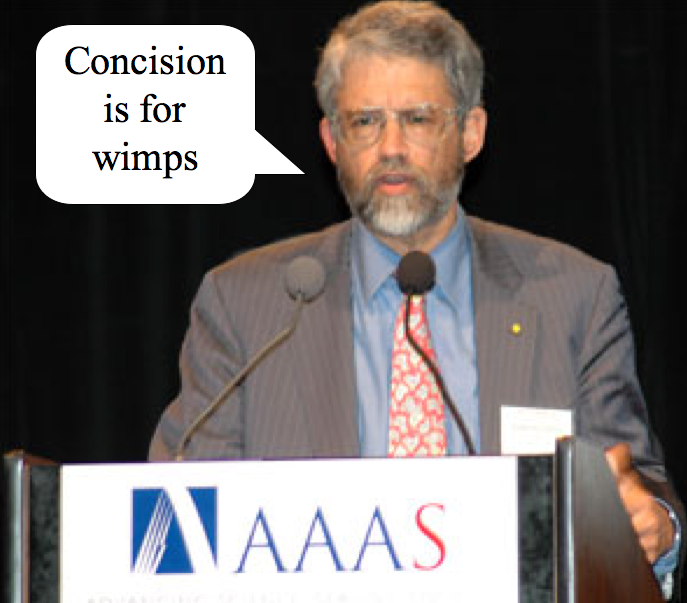#115) The Communications-impaired Brain of a Scientist: More is more, less is less
February 22nd, 2011
You can file this under, “It takes one to know one.” Try coming to the Q&A of one of my talks where I go on and on and on, until I can finally see thought bubbles above the crowd saying, “Is he really only going to let us ask one question?” I’m as bad as any scientist, but at least I know it’s a problem.
Wouldn’t you think the President’s Science Advisor would have a team of assistants to help him make a great presentation?
A SUPPORT GROUP FOR VICTIMS OF SCIENTIST ABUSE
Last year I spoke at a science institution where the day ended with what could be called a “Support Group for Victims of Scientist Abuse.” It was eight of their communications people telling sad stories of scientists getting mad at them. It ended with one woman, literally with tears in her eyes, recalling interviewing a scientist who told her about fifteen different projects he was doing. She wrote what she thought was a good article about his three most interesting and understandable projects, only to get a call from him tersely asking, “What happened to the other projects I told you about?”
As an old folk song used to sing, “When will they ever learn?”
I spent this past weekend at the AAAS meeting in Washington D.C. One friend told me about sitting through the talk from the President’s Science Advisor, John Holdren. She said he presented a stack of Powerpoint slides, each of which was packed with line after line of text in a talk that could only be described as bo-ho-ho-ring. She said, “Wouldn’t you think a big guy like that would have a team of advisors helping him put together a well crafted presentation?”
“BUT IT’S ALL IMPORTANT”
I see a similar pattern when I run my videomaking workshops with science students. They vote on the first morning for the 5 best projects. That afternoon the teams present their shot lists, which commonly will have about 18 different shots. I then say, “This is great. Now given that you have only one day to shoot it, it’s time to shrink your 18 shots down into … 2 shots.” We then set about cutting it down into two well conceived shots that will tell A LOT of what they want to say. But definitely not all of it. The finished product is only going to be 60 seconds long. Not only can you not fit that much information in, you don’t even want to try.
It turns into an exercise in leadership in which the filmmaker has to decide what is most important. And the answer, “But it’s ALL important,” doesn’t work. Even though that’s usually the first instinct.
You have to cut it down. Size (of information load) matters.
